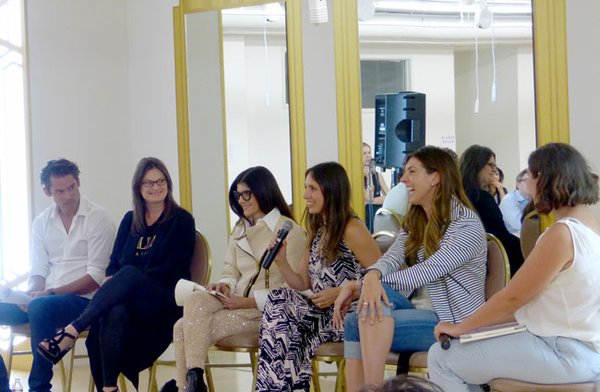THE PANEL: Nicolas Ullah, U.S. director of marketing for Trendstop; N. Jayne Seward, stylist, fashion journalist and creator of the VeryVeryChic blog; Kendra Gratteri, the director of merchandising for Beachmint; designer Rachel Pally; Alle Fister, principal with Bollare PR; and Kelsi Smith, founder of LA Fashion Council, StyleSmith, and Two Point Oh! LA
TECHNOLOGY
Fashion Group Talks Fashion, Tech, Social Media and E-commerce
Fashion, design and commerce in the digital age were discussed at an April 29 panel hosted by Fashion Group International–Los Angeles and held at Maker City LA, a new creative workspace at The Reef (formerly known as the LA Mart) in downtown Los Angeles.
Moderated by Kelsi Smith, founder of LA Fashion Council, StyleSmith and Two Point Oh! LA, the panel included designer Rachel Pally; Kendra Gratteri, the director of merchandising for Beachmint; Alle Fister, principal with Bollare PR; N. Jayne Seward, stylist, fashion journalist and creator of the VeryVeryChic blog; and Nicolas Ullah, U.S. director of marketing for Trendstop.
For several panelists, social media provides a way to quickly spot trends and find inspiration for their businesses.
By letting customers in on the design process, Gratteri said, she bypasses traditional fashion forecasting. “My customers are doing that for me,” she said.
Seward and Pally both said they find inspiration on social media.
“Five minutes on Instagram is like six months of magazines,” said Pally, who called social media a “constant flow of information.”
Trend forecasters can organize and make sense of that flow of information, Ullah said. “There are more data points to get trend intelligence. There’s a lot of information. As trend forecaster, it’s important to use social media to educate.”
Business intel
Social media provides instant access to information, but it also is a great tool for gathering feedback, Pally, Gratteri and Ullah said.
Ullah said he tracks how clients use his company’s trend reports. Gratteri said in addition to Beachmint’s customer-service team, she takes calls and monitors the company’s social media.
“I’m so grateful to get feedback—good or bad,” she said.
Pally said the feedback she gets can help determine the direction she takes or the colors she picks for the season. The designer said plus-size blogger Marie Denee, founder of The Curvy Fashionista, even inspired her to add new items to the line.
“She said, ‘Here are the things I want. I want a miniskirt,’” said Pally, who started added miniskirts to the Rachel Pally White Label collection last year.
Product placement with influential bloggers has also impacted sales, Pally said.
“If you have 100,000 followers, that’s a commodity,” she said. “But it has to be authentic. They have to believe in it.”
Social media also provides a look at how the fashion industry operates and a way to connect all the industry players working together.
“As a stylist, it’s important to have those followers,” Seward said. “If you post a behind-the-scenes photo at a shoot, [it gives] them an idea of the process.”
Social media also provides Seward with an opportunity to connect with and support the brands she’s working with.
“It’s nice to give shout-outs to brands,” she said.
Generating sales
The lines between information and commerce are blurring, Seward noted. E-commerce sites such as Nasty Gal, Planet Blue and Revolve create editorial lookbooks that customers eagerly follow on Instagram, while traditional publications are launching e-commerce sites such as Harper’s Bazaar’s ShopBazaar.com. “Even fashion week, the consumer is seeing that right now, and the demand is right now. It’s about being able to offer those products to their readers,” she said.
Some segments of the market are a perfect fit for social media–driven commerce.
“Millennials do a lot of browsing,” Gratteri said. “E-commerce is their entertainment playground.”
Pally said she’s seeing an “enormous shift to online shopping.” The power players are Shopbop and Revolve. Even department stores are seeing a shift to the [dot-com side of the businesses].”
Many in the audience were interested in using social-media platforms to generate sales.
Pally was bullish on social media’s impact on sales but said it depends on the platform.
“Followers equal dollars. It’s a great way to boost commerce,” she said but added what holds true for Instagram does not hold true for Facebook. “Likes does not equal dollars,” she said.
Keep it real
Social media also can provide a level of personal connection to the designer or brand.
“It’s an interesting shift,” Fister said. “You can be a digital friend of the designer. If you want a privileged peek into Rachel [Pally]’s life or someone guiding you through the shopping experience [like a digital merchandiser], the customer feels like they’ve had a special experience and hopefully spreads the word [on social media].”
Pally said her company notices the difference between a personal post online and one that may just include a stock photo.
Another way to keep it real is to get the consumer in on the merchandising and promotion of the line. Pally pointed to retailer Freepeople, which encourages customers to upload photos of themselves wearing the clothing. “You can see how 80 or 200 or 400 people have worn that same dress,” she said.
Sites can also encourage add-on sales by recommending an entire outfit for you based on the item you’re looking at. “It used to be the salesgirl’s role,” Pally said. “Now the algorithm curates it for you.”
Ullah agreed, saying his company looks closely at the data behind different social-media channels to determine the best fit.
For example, he said, “If I’m a lingerie brand and more than 90 percent of my customers are female, I’m going to pay more attention for Pinterest [which has a much higher percentage of female users than other platforms]. It’s about really looking into the social-media channels and what makes sense for us.”






















